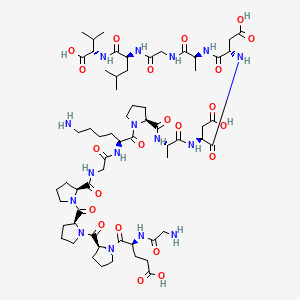BPC-157: Unveiling the Healing Potential of a Synthetic Peptide
In the realm of regenerative medicine, BPC-157 has garnered attention for its purported healing properties. Derived from a protein found in human gastric juice, this synthetic peptide comprises 15 amino acids and is often referred to as “Body Protection Compound 157.” While animal studies have shown promising results, the translation of these findings to human applications remains a subject of ongoing research and debate.

Understanding BPC-157
BPC-157 is a fragment of a naturally occurring protein in the stomach, believed to play a role in protecting and healing the gastrointestinal tract. Its synthetic counterpart has been studied for its potential to accelerate healing processes in various tissues, including muscles, tendons, ligaments, and nerves.
IUPAC Condensed H-Gly-Glu-Pro-Pro-Pro-Gly-Lys-Pro-Ala-Asp-Asp-Ala-Gly-Leu-Val-OH
Sequence GEPPPGKPADDAGLV
PLN H-GEPPPGKPADDAGLV-OH
HELM PEPTIDE1{G.E.P.P.P.G.K.P.A.D.D.A.G.L.V}$$$$
IUPAC glycyl-L-alpha-glutamyl-L-prolyl-L-prolyl-L-prolyl-glycyl-L-lysyl-L-prolyl-L-alanyl-L-alpha-aspartyl-L-alpha-aspartyl-L-alanyl-glycyl-L-leucyl-L-valine
Mechanisms of Action
Research suggests that BPC-157 may exert its effects through several mechanisms:
- Angiogenesis Promotion: BPC-157 has been observed to stimulate the formation of new blood vessels, a critical component in tissue repair and regeneration.
- Collagen Production: It may enhance collagen synthesis, providing structural support to healing tissues.
- Anti-Inflammatory Effects: The peptide appears to modulate inflammatory responses, potentially reducing swelling and pain associated with injuries.
- Cellular Protection: BPC-157 might protect cells from oxidative stress and apoptosis, aiding in tissue preservation during the healing process.
Evidence from Animal Studies
Numerous animal studies have investigated the therapeutic potential of BPC-157:
- Tendon and Ligament Healing: In rodent models, BPC-157 has been shown to accelerate the healing of transected tendons and ligaments, promoting fibroblast proliferation and collagen deposition.
- Muscle Regeneration: Studies indicate enhanced muscle healing following injury, with improved muscle fiber organization and reduced fibrosis.
- Nerve Repair: BPC-157 has demonstrated neuroprotective effects, supporting nerve regeneration and functional recovery in animal models of nerve injury.
- Gastrointestinal Protection: The peptide has been effective in healing gastric ulcers and mitigating damage from toxins in the digestive tract.
While these findings are encouraging, it’s important to note that results in animal models do not always translate directly to human outcomes.
Human Research and Clinical Use
Human studies on BPC-157 are limited. Some anecdotal reports and preliminary research suggest potential benefits in treating conditions like inflammatory bowel disease, tendon injuries, and muscle strains. However, comprehensive clinical trials are necessary to establish efficacy and safety in humans.
Currently, BPC-157 is not approved by the U.S. Food and Drug Administration (FDA) for medical use. The World Anti-Doping Agency (WADA) has also listed it as a prohibited substance, citing concerns over its unregulated status and potential for misuse in sports.
Legal and Safety Considerations
The unregulated nature of BPC-157 raises several concerns:
- Quality Control: Products available online may vary in purity and concentration, leading to unpredictable effects.
- Lack of Oversight: Without regulatory approval, there’s limited information on appropriate dosing, potential side effects, and long-term safety.
- Ethical Implications: The use of unapproved substances in sports and therapy raises ethical questions and potential legal ramifications.

Discussion about this post